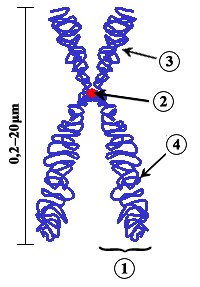
| Home | Sources Directory | News Releases | Calendar | Articles | | Contact | |
Locus (genetics)
In the fields of genetics and evolutionary computation, a locus (plural loci) is the specific location of a gene or DNA sequence on a chromosome. A variant of the DNA sequence at a given locus is called an allele. The ordered list of loci known for a particular genome is called a genetic map. Gene mapping is the process of determining the locus for a particular biological trait.
Diploid and polyploid cells whose chromosomes have the same allele of a given gene at some locus are called homozygous with respect to that gene, while those that have different alleles of a given gene at a locus, heterozygous with respect to that gene.
[edit] Nomenclature
The chromosomal locus of a gene might be written "6p21.3".
| Component | Explanation |
| 6 | The chromosome number. |
| p | The position is on the chromosome's short arm (p for petit in French); q indicates the long arm. |
| 21.3 | The numbers that follow the letter represent the position on the arm: band 2, section 1, sub-band 3. The bands are visible under a microscope when the chromosome is suitably stained. Each of the bands is numbered, beginning with 1 for the band nearest the centromere. Sub-bands and sub-sub-bands are visible at higher resolution. |
A range of locations is specified in a similar way. For example, the locus of gene OCA1 may be written "11q1.4-q2.1", meaning it is on the long arm of chromosome 11, somewhere in the range from sub-band 4 of band 1, and sub-band 1 of band 2.
The ends of a chromosome are labeled "ptel" and "qtel", and so "2qtel" refers to the telomere of the long arm of chromosome 2.
[edit] See also
[edit] External links
| This genetics article is a stub. You can help Wikipedia by expanding it. |
|
SOURCES.COM is an online portal and directory for journalists, news media, researchers and anyone seeking experts, spokespersons, and reliable information resources. Use SOURCES.COM to find experts, media contacts, news releases, background information, scientists, officials, speakers, newsmakers, spokespeople, talk show guests, story ideas, research studies, databases, universities, associations and NGOs, businesses, government spokespeople. Indexing and search applications by Ulli Diemer and Chris DeFreitas.
For information about being included in SOURCES as a expert or spokesperson see the FAQ . For partnerships, content and applications, and domain name opportunities contact us.

